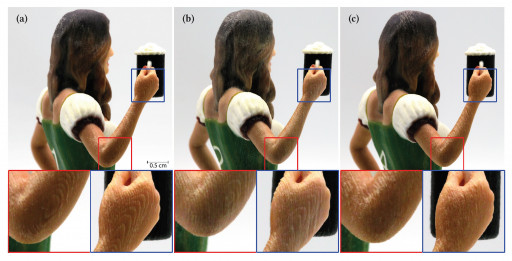
Fraunhofer IGD - elimination of stair-step artifacts in multi-material 3D printing
Stair-step artifacts - (a) - are not only visually disturbing, but can also be detrimental to printing. Existing techniques for minimizing quantization errors only partially avoid them (b). The new shape dithering method (c) completely removes these.
DARMSTADT, Germany - July 28, 2022 - (Newswire.com)
Scientists at Fraunhofer IGD have devised a purely geometric and algorithmic method for the elimination of stair-step artifacts in multi-material 3D printing. To avoid quantization errors, the surface of the object is modulated with a high-frequency signal. This results in geometrically accurate and color-true surfaces. The research team has set down their findings in a paper - Shape Dithering for 3D Printing - which will be published to coincide with SIGGRAPH, the premier conference and exhibition on computer graphics and interactive techniques.
Stair-step artifacts are unavoidable in conventional 3D printing processes. They are visually disturbing and can even be structurally detrimental to the print. To generate more accurate surfaces, researchers at the Fraunhofer Institute for Computer Graphics Research IGD have developed a new process for polyjet printers. It minimizes quantization errors so that stair-step artifacts are no longer noticeable in actual printing and are at a level far below the physical effects of the printing process. This results in objects with a smoother and more uniform surface.
Entertainment industry benefits from high-quality print results
To achieve the desired effect, the surface of the object is modulated with a high-frequency signal, such as blue noise. This leads to a distribution of quantization errors to high frequencies, which are then later removed by the function of the human eye and multiple printing processes. Alan Brunton, a member of the three-person author team, explains: "The printing time remains the same, regardless of the process. The dithering process does not require additional computing time either."
The process is used, for example, in the entertainment industry. Figures and objects are printed for animated movies, video games and board games. In contrast to previous processes, they benefit from the geometric and color precision conferred by the shape dithering approach and thus look especially realistic.
Flexible application
The dithering process can be used as a purely algorithmic method independently of the hardware, i.e. with different polyjet 3D printers. The solution presented in the research paper is used with the Cuttlefish 3D printer driver developed by Fraunhofer IGD. Based on the results now published, in future, the scientists will investigate the further hypothesis of whether the smoother surface of the printed objects also makes them more resilient.
The paper - Shape Dithering for 3D Printing - has been accepted for presentation at SIGGRAPH 2022, the leading trade fair for computer graphics. The conference will be held as a hybrid event, both virtually and in person in Vancouver, in the week of 8-11 August. Mostafa Morsy Abdelkader Morsy, lead author of the paper, will be presenting it on behalf of the research team on 9 August at 10:45 a.m. local time.
For more information - the entire paper and supplemental materials can be found at:
- https://www.cuttlefish.de/publications
- https://dl.acm.org/doi/10.1145/3528223.3530129
Watch the video: https://www.youtube.com/watch?v=ps4m5WDqrbM
--
Fraunhofer IGD at SIGGRAPH 2022 - August 8-11
Our Presentation - August 9, 10:45 a.m.
--
About Fraunhofer IGD: Since 1987, the Fraunhofer Institute for Computer Graphics Research IGD has been setting international standards for applied research in visual computing, the branch of computer science that deals with images and 3D models. We transform information into images as well as images into information, and we support industry and business in their strategic development. Keywords here are human-machine interaction, virtual and augmented reality, artificial intelligence, interactive simulation, modeling, 3D printing and 3D scanning. Around 180 research staff at the three sites in Darmstadt, Rostock and Kiel are generating new technological application solutions and prototypes for Industry 4.0, digital healthcare and the smart city. Our products take on international relevance through our partnership with the sister institute in Graz and Klagenfurt. Our matrix organization enables us to serve our clientele from a wide range of industries with technical and competitive services relevant to their needs. For this purpose, we have assembled cross-functional teams of experts with extensive industry experience, who also take on planning, management and evaluation responsibilities for projects of any magnitude.
Media contact:
Daniela Welling | Head of Corporate Communications
Fraunhofer Institute for Computer Graphics Research IGD
Fraunhoferstraße 5 | 64283 Darmstadt - Germany
Phone +49 6151 155-146 | presse@igd.fraunhofer.de | https://www.igd.fraunhofer.de
Press Release Service by Newswire.com
Original Source: Innovation in 3D Printing - Fraunhofer IGD Develops New Process for the Avoidance of Stair-Step Artifacts
